|
|
|
|
|
|
|
|
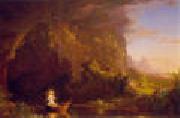 |
Thomas Cole
|
|
1801-1848
Thomas Cole Galleries
Thomas Cole (February 1, 1801 - February 11, 1848) was a 19th century American artist. He is regarded as the founder of the Hudson River School, an American art movement that flourished in the mid-19th century. Cole's Hudson River School, as well as his own work, was known for its realistic and detailed portrayal of American landscape and wilderness, which feature themes of romanticism and naturalism.
In New York he sold three paintings to George W. Bruen, who financed a summer trip to the Hudson Valley where he visited the Catskill Mountain House and painted the ruins of Fort Putnam. Returning to New York he displayed three landscapes in the window of a bookstore; according to the New York Evening Post, this garnered Cole the attention of John Trumbull, Asher B. Durand, and William Dunlap. Among the paintings was a landscape called "View of Fort Ticonderoga from Gelyna". Trumbull was especially impressed with the work of the young artist and sought him out, bought one of his paintings, and put him into contact with a number of his wealthy friends including Robert Gilmor of Baltimore and Daniel Wadsworth of Hartford, who became important patrons of the artist.
Cole was primarily a painter of landscapes, but he also painted allegorical works. The most famous of these are the five-part series, The Course of Empire, now in the collection of the New York Historical Society and the four-part The Voyage of Life. There are two versions of the latter, one at the National Gallery in Washington, D.C., the other at the Munson-Williams-Proctor Arts Institute in Utica, New York.
Cole influenced his artistic peers, especially Asher B. Durand and Frederic Edwin Church, who studied with Cole from 1844 to 1846. Cole spent the years 1829 to 1832 and 1841-1842 abroad, mainly in England and Italy; in Florence he lived with the sculptor Horatio Greenough. |
|
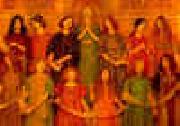 |
Thomas Cooper Gotch
|
|
1854-1931
English
Thomas Cooper Gotch Gallery
In Newlyn he worked first at painting local scenes in the then-fashionable realist manner. But even these often had a romantic edge, such as The Wizard or an obvious love of surface colour.
In 1891 a visit to Florence, Italy, opened his eyes to the work of the romantic European symbolists. He took the brave step of changing his style, to make romantic decorative paintings, when the prevailing fashion was against him. His first work in this new style was My Crown and Sceptre (1892), which was the progenitor to his most well-known work The Child Enthroned (1894). The latter, on original exhibition, was hailed by The Times newspaper as the star of that year's Royal Academy show. Until that time, his new style of work had drawn much critical scorn.
He painted religious Christian scenes, history painting, portraits, and a few landscapes. His best-known paintings, which form the bulk of his work, usually portray girl-children in ornate classical or medievalist dress. The appearance of the girls in his paintings is often noted as being very modern. Gotch was a close and lifelong friend of Henry Scott Tuke, whose work featured a parallel focus on the boy-child. Gotch's lifelong adoration of the beautiful girl-child was shared by other Victorian giants such as John Ruskin and Lewis Carroll.
His emotionally-charged work was immensely popular and critically acclaimed for most of his life, although interest in neo-romanticism waned after the First World War and he turned to watercolours of flowers. He also illustrated books, such as Round About Wiltshire, The Land of Pardons (an early study of Breton folklore & Celtic Christianity), and contributed illustrations to school readers such as Highroads of Literature.
A retrospective show was held in Newcastle in 1910, and a memorial exhibition in Kettering in 1931. |
|
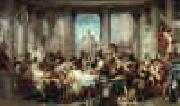 |
Thomas Couture
|
|
1815-1879
French
Thomas Couture Location
French painter and teacher. A student of Antoine-Jean Gros in 1830-38 and Paul Delaroche in 1838-9, he demonstrated precocious ability in drawing and was expected to win the Prix de Rome. He tried at least six times between 1834 and 1839, but achieved only second prize in 1837 (entry untraced). Disgusted with the politics of the academic system, Couture withdrew and took an independent path. He later attacked the stultified curriculum of the Ecole des Beaux-Arts and discouraged his own students from entering this institution. He first attained public notoriety at the Paris Salon with Young Venetians after an Orgy (1840; Montrouge, priv. col., see Boime, p. 85), the Prodigal Son (1841; Le Havre, Mus. B.-A.) and the Love of Gold (1844; Toulouse, Mus. Augustins). These early canvases are treated in a moralizing and anecdotal mode; the forms and compositional structures, like the debauched and corrupt protagonists, are sluggish and dull. Yet what made his work seem fresh to the Salon audience was his use of bright colour and surface texture derived from such painters as Alexandre-Gabriel Decamps and Eugene Delacroix, while his literary bent and methodical drawing demonstrated his mastery of academic tradition. The critics Thophile Gautier and Paul Mantz (1821-95) proclaimed him as the leader of a new school that mediated between the old and the new, and looked to him for a revitalization of Salon painting. The air of compromise his works projected made him appear a cultural representative of the juste milieu policies of Louis-Philippe. |
|
|
|
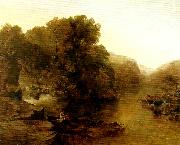 |
thomas creswick
|
|
Thomas Creswick (5 February 1811 - 28 December 1869) was an English landscape painter and illustrator, born in Sheffield, son of Thomas Creswick and Mary Epworth and educated at Hazelwood, near Birmingham.
At Birmingham he first began to paint. His earliest appearance as an exhibitor was in 1827, at the Society of British Artists in London; in the ensuing year he sent to the Royal Academy the two pictures named Llyn Gwynant, Morning, and Carnarvon Castle. About the same time he settled in London; and in 1836 he took a house in Bayswater. He soon attracted some attention as a landscape painter, and had a career of uniform and encouraging, though not signal success. In 1842 he was elected an associate, and in 1850 a full member of the Royal Academy, which, for several years before his death, numbered hardly any other full members representing this branch of art.
In his early practice he set an example, then too much needed, of diligent study of nature out of doors, painting on the spot all the substantial part of several of his pictures. English and Welsh streams may be said to have formed his favourite subjects, and generally British rural scenery, mostly under its cheerful, calm and pleasurable aspects, in open daylight. This he rendered with elegant and equable skill, color rather grey in tint, especially in his later years, and more than average technical accomplishment; his works have little to excite, but would, in most conditions of public taste, retain their power to attract.
Creswick was industrious and extremely prolific; he produced, besides a steady outpouring of paintings, numerous illustrations for books. He was personally genial, a dark, bulky man, somewhat heavy and graceless in aspect in his later years. He died at his house in Bayswater, Linden Grove, after a few years of declining health. Among his principal works may be named England (1847); Home by the Sands, and a Squally Day (1848); Passing Showers (1849); The Wind on Shore, a First Glimpse of the Sea, and Old Trees (1850); A Mountain Lake, Moonrise (1852); Changeable Weather (1865); also the London Road, a Hundred Years ago; The Weald of Kent; the Valley Mill (a Cornish subject); a Shady Glen; the Windings of a River; the Shade of the Beech Trees; the Course of the Greta; the Wharfe; Glendalough, and other Irish subjects, 1836 to 1840; the Forest Farm Frith for figures, and Ansdell for animals, occasionally worked in collaboration with Creswick. |
|
|
|
|
|
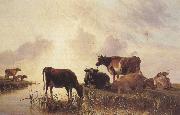 |
Thomas sidney cooper,R.A.
|
|
1803-1902
English painter. He was encouraged in his ambition to become an artist by Sir Thomas Lawrence and the animal painter Abraham Cooper (no relation; 1787-1868). He entered the Royal Academy Schools, London, in 1823. He subsequently taught art in Brussels where he met Eugene Verboeckhoven, whose work had a profound influence on him. Through Verboeckhoven he came to appreciate the work of such 17th-century Dutch painters as Aelbert Cuyp and Paulus Potter. In 1831 he returned to London, exhibiting at the Royal Society of British Artists. He exhibited 48 pictures at the British Institution between 1833 and 1863. The majority of his work was, however, exhibited at the Royal Academy; from 1833 to 1902 he exhibited 266 works there without a break, |
|
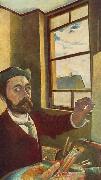 |
Tivadar Kosztka Csontvary
|
|
born 1853 - d. 1919) was a Hungarian painter. He was one of the first Hungarian painters to become well known in Europe.
Csontvery was born on 5 July 1853 in Kisszeben, Seros County, Kingdom of Hungary (today Sabinov, Slovakia), and died 20 June 1919 in Budapest. His ancestors were Poles who settled down in Hungary. Although Csontvery was obsessed with his Magyar roots, he himself grew up speaking Slovak mixed with German. He was a pharmacist until his twenties. On a hot sunny afternoon, 13 October 1880, e when he was 27 years old e he experienced a mystic vision. He heard a voice saying "you will be the greatest sunway painter, greater than Raphael!" He took journeys around Europe, visited the galleries of the Vatican, then went home to collect money for his journeys working as an apothecary. From 1890 onwards he traveled around the world. He visited Paris, the Mediterraneum (Dalmatia, Italy, Greece), North Africa and the Middle East (Lebanon, Palestine, Egypt, Syria) and painted pictures. He painted his major works between 1903 and 1909. He had some exhibitions in Paris (1907) and Western Europe. Most of the critics in Western Europe recognized his abilities, art and congeniality, but in the Kingdom of Hungary during his life he was considered to be an eccentric crank for several reasons, e. g. for his vegetarianism, anti-alcoholism, anti-nicotinism, pacifism, his latent, but more and more apparent schizophrenia and his cloudy, prophetic writings and pamphlets about his life (Curriculum), genius (The Authority, The Genius) and religious philosophy (The Positivum). Even though later he was acclaimed, during his lifetime Csontvery's visionary, expressionistic style found little understanding. A loner by nature, the master's mental balance was upset by his efailuree impairing his creative power. Little did he know that some years after his death, an entire museum in Paris, Hungary, would be devoted to his paintings, and that worldwide appreciation of his works would be in constant ascendancy. Many painters, e.g. Picasso added a stone to Csontvery's cairn.
|
|
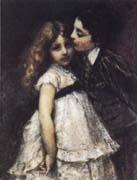 |
Tranquillo Cremona
|
|
Italian Painter , 1837-1878
Italian painter. The son of an Austrian government official, Cremona began his artistic education in 1849 at the art school in Pavia, where he encountered three Lombard artists who were an important influence on his early studies: Giacomo Tr?court (1812-82), head of the school; Giovanni Carnevali, Tr?court's friend and a frequent visitor to Pavia; and Federico Faruffini, also a student at Pavia. All three were interpreters of the curiously soft and subtle form of Romanticism, derived from Andrea Appiani, that was to be found in this specific form only in Italy. In 1852 Cremona moved to Venice, where he enrolled at the Accademia. His teachers, who included Ludovico Lipparini (1800-56), Michelangelo Grigoletti (1801-70) and Antonio Zona (1814-92), were well versed in the more academic form of Romanticism expressed by Francesco Hayez, although in Zona the rather rigid, academic linearity was attenuated by a softer sense of form and colour. The Venetian Old Masters were a greater influence on Cremona's ultimate use of colour than was his academy training. In 1859, to avoid military service with the Austrian Army, Cremona moved to Piedmont. |
|
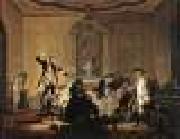 |
TROOST, Cornelis
|
|
Dutch painter (b. 1697, Amsterdam, d. 1750, Amsterdam).
Dutch painter, draughtsman and printmaker. He was the most important Dutch artist of the 18th century; he received many commissions (the catalogue by Niemeijer contains 925 numbers). Although he generally looked back to the genre scenes of the Dutch 17th-century masters, his satirical paintings earned him the nickname 'the Dutch Hogarth' after his English contemporary. |
|
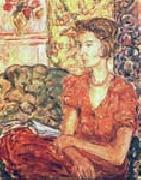 |
Tytus Czyzewski
|
|
(1880-1945) was a Polish painter, art theoretician, Futurist poet, playwright, member of the Polish Formists, and Colorist.
In 1902 he studied at the Academy of Fine Arts in Krakow in the painting studios of Jezef Mehoffer and Leon Wycz??łkowski. Czyżewski travelled to Paris and learned from the artistic trends there. He began exhibiting in 1906. Czyżewski painting style was highly influenced by Cezanne and El Greco, whose work he admired until his death.
In 1917, with the brothers Zbigniew Pronaszko and Andrzej Pronaszko, he organized in Krakew an exhibition of Polish Expressionist works. The group later became known as the Polish Formists. Until the break-up of the Formists in 1922, he was the primary artist and theoretician behind the movement as well as the joint editor of the periodical Formiści. |
|
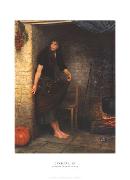 |
Valentine Cameron Prinsep Prints
|
|
Indian-born British Pre-Raphaelite Painter, 1838-1904
Henry Prinsep was an intimate friend of G. F. Watts, under whom his son first studied. Val Prinsep also worked in Paris in the atelier Gleyre; and 'Taffy' in his friend George du Maurier's novel Trilby, is said to have been sketched from him. He was an intimate friend of John Everett Millais and of Burne-Jones, with whom he travelled in Italy. He had a share with Rossetti and others in the decoration of the hall of the Oxford Union.
Prinsep first exhibited at the Royal Academy in 1862 with his Bianca Capella, his first picture, which attracted marked notice, being a portrait (1866) of General Gordon in Chinese costume. Princep lent the costume to Millais who used it in his own painting Esther.
The best of his later exhibits were A Versailles, The Emperor Theophilus chooses his Wife, The Broken Idol and The Goose Girl. He was elected A.R.A. in 1879 and R.A. in 1894. In 1877 he went to India and painted a huge picture of the Delhi Durbar, exhibited in 1880, and afterwards hung at Buckingham Palace. |
|
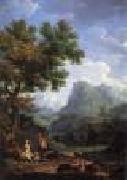 |
VERNET, Claude-Joseph
|
|
French Painter, 1714-1789
Painter. Vernet probably received his first lessons in painting from his father, Antoine, who then encouraged him to move to the studio of Philippe Sauvan (1697-1792), the leading master in Avignon. Sauvan supplied altarpieces to local churches and decorative works and mythologies for grand houses in the area. After this apprenticeship Vernet worked in Aix-en-Provence with the decorative painter Jacques Viali ( fl 1681- 1745), who also painted landscapes and marine pictures. In 1731 Vernet independently produced a suite of decorative overdoors for the h?tel of the Marquise de Simiane at Aix-en-Provence; at least two of these survive (in situ) and are Vernet's earliest datable landscapes. These are early indications of his favoured type of subject, and Vernet would have studied works attributed to such 17th-century masters as Claude Lorrain, Gaspard Dughet and Salvator Rosa in private collections at Aix and Avignon. Three years later Joseph de Seytres, Marquis de Caumont, who had previously recommended Vernet to the Marquise de Simiane, offered to sponsor a trip to Italy. |
|
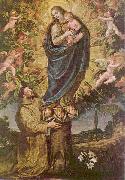 |
Vicente Carducho
|
|
(in Spanish, sometimes Vicencio or Vicente Carducho; 1568-1638) was an Italian painter.
He was born in Florence, and was trained as a painter by his brother Bartolomeo, whom he followed to Madrid as a boy.
He Initially painted some works at Valladolid and helped his brother in painting at the Escorial for Philip II of Spain. He returned to the court of Philip III in Madrid in 1606 and helped decorate the recently rebuilt Palacio del Pardo. While at work his brother died, and Vicente took his place. He painted there a history of Achilles. When finished, he was employed for four years by the monks of the Chartreuse of el Paular to decorate their monastery with 55 canvases of historical figures the great cloister. 27 represent the live of St. Bruno, 27 of martyrs.
He worked a great deal for the subsequent monarch, Philip IV, and his best pictures are those he executed for him as decorations in the Prado. Examples of his work are preserved at Toledo, Segovia, and several other Spanish cities. For many years he labored in Madrid as a teacher of his art, and among his pupils were Giovanni Ricci, Pedro Obregon, Vela,[disambiguation needed ] Francisco Collantes, and other distinguished representatives of the Spanish school during the 17th century.
He also authored a treatise, De las Excelencias de la Pintura or Dielogos de la pintura, su defensa, origen, essencia, definicien, modos, y differencias, published in 1633. Written in classical tradition as a dialogue between a master and an apprentice. Following strict piety of the Spanish realm,
|
|
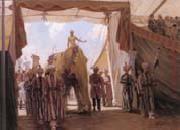 |
Victor C.Anderson
|
|
a well known Hudson River School painter,
American , 1882-1937
was an American painter and illustrator, primarily known for his rural life scenes and landscapes, whose works were featured in Life and other magazines of the early 20th Century, and who produced a wide range of illustrations for books as well as oil paintings. Like his father, Frank Anderson, Victor was a well-known painter of the Hudson River School. Victor drew and painted from an early age, eventually entering the Pratt Institute in Brooklyn. His favorite subjects were scenes of homespun rural life and landscapes of the late 19th and early 20th Centuries, and were popular nationally. For many years, he lived and had his studio at 195 Battle Avenue, White Plains, New York, where he died in 1937. He exhibited in the National Academy. His daughter, Joan Howe (1915-2005), was a well-known watercolor artist . |
|
 |
VIGNON, Claude
|
|
French Baroque Era Painter, 1593-1670
French painter, printmaker and illustrator. Born into a prosperous family in Tours, he received his early training in Paris, probably in Jacob Bunel's studio. In 1609-10 he travelled to Rome; although his presence there is recorded only in 1618-20, he was probably based there throughout that decade, becoming a member of the community of young French artists that included Simon Vouet and Valentin de Boullogne. They were all predominantly influenced by the art of Caravaggio and of his most direct follower Bartolomeo Manfredi. Vignon's severe half-length figures (St Paul, Turin, Gal. Sabauda; Four Church Fathers, on loan to Cambridge, Fitzwilliam), executed possibly even earlier than 1615, are in a Caravaggesque style, as are his paintings of singers, musicians and drinkers (e.g. the Young Singer, Paris, Louvre), although the latter group owes more to the style of contemporary genre painting. However, Vignon was already showing an interest in new artistic experiments, the origins of which were northern, Venetian and Mannerist. His sensitivity to the splendid colouring of Venice and to the art of Jacques Bellange, Georges Lallemand and Jacques Callot is manifest in his Martyrdom of St Matthew (1617; Arras, Mus. B.-A.), a work with striking references to Caravaggio's painting of the same subject (Rome, S Luigi dei Francesi), and still more so in his Adoration of the Magi (1619; Dayton, OH, A. Inst.), which also shows clear links with the art of several precursors of Rembrandt, including Adam Elsheimer, Pieter Lastman, Jakob Pynas and particularly Leonard Bramer. |
|
|
|
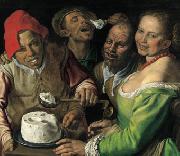 |
Vincenzo Campi
|
|
Vincenzo Campi (c. 1536 - 1591) was an Italian painter of the Renaissance from Cremona.
His style merges Lombard with Mannerist styles, however, unlike his siblings, he is known for a series of canvases, mostly painted after 1570s [1], displaying genre scenes and local produce. Many set at a food store front of some sort. At the time, this type of paintings were uncommon in Italy, and more common in Netherlands, as exemplified by the canvases of Joachim Beuckelaer.
In Cremona, his extended family was the main artistic studio of his time. Giulio Campi and Antonio Campi were reportedly half-brothers, while Bernardino Campi was a distant relative. All were active and prominent local painters. In 1586-1589, he and his brother Antonio completed paintings for the church of San Paolo Converso in Milan.
|
|
|
|
 |
Vincenzo Catena
|
|
Italian
c1480-1531
Vincenzo Catena Location
Italian painter. His paintings represent the perpetuation of the style of Giovanni Bellini into the second quarter of the 16th century. He made few concessions to the modern style that was being introduced to Venice by Titian, Palma Vecchio, Pordenone and others in the same period. This archaicizing tendency was shared by several minor Bellinesque painters of the period, including Pietro degli Ingannati, Pietro Duia, Francesco Bissolo, Vittore Belliniano and the Master of the Incredulity of St Thomas. Catena, together with Marco Basaiti, with whose works Catena are sometimes confused, can be considered the most accomplished of these. Despite the fact that he counted several humanists in his circle, the extant repertory of his subjects is limited to religious themes, mainly Marian and including three altarpieces, and to male portraits. The latter, as Vasari observed, include several of his finest works. |
|
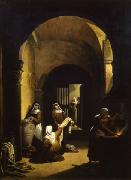 |
Vincenzo Chialli
|
|
was born at Citte di Castello in 1787. After having learned the rudiments of art in that town, he visited Rome at the age of seventeen years, and became a disciple of Camuccini, whom he afterwards imitated. After leaving Rome he painted religious subjects at Borgo San Sepolcro, Urbino, Pesaro, and Venice, from whence he retraced his steps to Rome; but as the climate did not suit him, he left that city in 1822 and returned to Citta di Castello. He became Director of the School of Painting at Cortona in 1835, and died in 1840. |
|
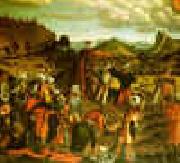 |
Vittore Carpaccio
|
|
Italian
1455-1526
Vittore Carpaccio Locations
His name is associated with the cycles of lively and festive narrative paintings that he executed for several of the Venetian scuole, or devotional confraternities. He also seems to have enjoyed a considerable reputation as a portrait painter. While evidently owing much in both these fields to his older contemporaries, Gentile and Giovanni Bellini, Carpaccio quickly evolved a readily recognizable style of his own which is marked by a taste for decorative splendour and picturesque anecdote. His altarpieces and smaller devotional works are generally less successful, particularly after about 1510, when he seems to have suffered a crisis of confidence in the face of the radical innovations of younger artists such as Giorgione and Titian.
|
|
|
|
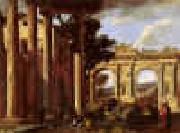 |
Viviano Codazzi
|
|
1604-1670
Italian
Viviano Codazzi Location
1670). Italian painter. He arrived in Naples about 1634, having almost certainly trained in Rome. He was a specialist in the realistic architectural VEDUTA, and his interest in this theme may have been stimulated in Rome by the quadratura frescoes of Agostino Tassi and by the urban views of Claude Lorrain and Herman van Swan. |
|
 |
VOS, Cornelis de
|
|
Flemish painter (b. 1584/85, Hulst, d. 1651, Antwerpen)
Flemish portrait and figure painter. He was a contemporary of Rubens, who sent many sitters to him. Although of the school of Rubens, Vos developed an individual style of portraiture in which cool grays predominate. His representations of children were particularly successful. An example of his many portraits is that of Abraham Grapheus (Antwerp). His brother, Paulus de Vos, c.1596 C1678, was an excellent painter of animals and hunting scenes. His paintings show the influence of his brother-in-law, Frans Snyders. |
|
 |
Walter Crane
|
|
English Golden Age Illustrator, 1845-1915
English painter, illustrator, designer, writer and teacher. He showed artistic inclinations as a boy and was encouraged to draw by his father, the portrait painter and miniaturist Thomas Crane (1808-59). A series of illustrations to Tennyson's The Lady of Shalott (Cambridge, MA, Harvard U., Houghton Lib.) was shown first to Ruskin, who praised the use of colour, and then to the engraver William James Linton, to whom Crane was apprenticed in 1859. From 1859 to 1862 Crane learnt a technique of exact and economical draughtsmanship on woodblocks. |
|
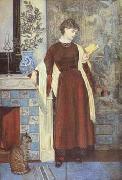 |
Walter Crane,RWS
|
|
1845-1915
English painter, illustrator, designer, writer and teacher. He showed artistic inclinations as a boy and was encouraged to draw by his father, the portrait painter and miniaturist Thomas Crane (1808-59). A series of illustrations to Tennyson's The Lady of Shalott (Cambridge, MA, Harvard U., Houghton Lib.) was shown first to Ruskin, who praised the use of colour, and then to the engraver William James Linton, to whom Crane was apprenticed in 1859. From 1859 to 1862 Crane learnt a technique of exact and economical draughtsmanship on woodblocks. His early illustrative works included vignette wood-engravings for John R. Capel Wise's The New Forest: Its History and its Scenery (1862). |
|
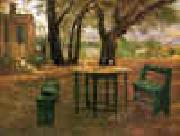 |
Walter I Cox
|
1866-1930
English
Can you freeze blue apron meals
Are you a busy parent or an overwhelmed office worker who just doesn??t have the time for cooking? You know what it feels like to be tired and famished but lack the energy to cook, right? If so, then Blue Apron meals might just sound like a lifesaver! Though they provide scrumptious home-cooked meals in minutes, do you ever find yourself with more meal options than you can eat that week? Well have we got good news for you - yes, indeed you *can* freeze Blue Apron Meals! Keep reading to find out exactly how.
Exploring freezing blue apron meals - what recipes can you freeze, and for how long
Exploring freezing Blue Apron meals can be a fun and flavorful way to enjoy later in the month. Whether you've just received your delivery or need to preserve leftovers, most of Blue Apron's recipes can be frozen for up to three months. Many seafood dishes, such as recipes involving white fish, salmon and shellfish, do not freeze well and should be consumed within 1-2 days. Other dishes, such as stir-fries, braises, stews, soups and pastas lend themselves particularly well for freezing. When making these dishes at home from a Blue Apron kit or Hellofresh kit hellofreshvsblueapron, simply portion out individual servings in airtight containers before freezing. Once you're ready to reheat the meal again, simply place the container back in the fridge overnight before cooking!
How to choose the best meals from blue apron to freeze
Freezing meals from Blue Apron is a great way to make sure you're always prepared for mealtimes. Depending on your tastes and preferences, there are a few tips and tricks you should bear in mind when selecting meals to freeze. Firstly, if you're aiming for the best possible quality upon defrosting, look for recipes with minimal dairy content. Dairy does not survive freezing well and can lead to a gritty texture after thawing. Secondly, consider recipes containing more neutral ingredients like vegetables or fish, as these will retain their flavors better than more robust options such as steak or pork chops. Lastly, be mindful of highly-seasoned ingredients as these tend to lose flavor faster than basic ones when frozen. Doing these things will ensure that by taking the time to freeze a meal now, you'll be able to enjoy it later at its peak flavor level!
Tips for prepping and packaging blue apron meals before freezing them
Prepping and packaging blue apron meals before freezing them is a simple but effective way to save time when cooking during the week. For best results, it??s important to properly season the un-prepped pre-measured ingredients prior to combining them. This will make sure that the flavors of the meal are properly distributed. Once seasoned, combine the ingredients in one large bowl or dish, this will make packaging easier and result in less waste. Transferring prepped meals into storage bags or containers should be done quickly in order to properly seal out air, this will keep your meal fresher for longer. Finally, don??t forget to label each bag with the name of dish and date you prepped it. Following these simple tips for prepping and packaging blue apron meals before freezing them will ensure you have delicious home cooked meals ready throughout the week without spending hours putting dishes together from scratch!
What effects does freezing have on the nutritional content of blue apron meals
Flash freezing is incredibly beneficial to blue apron meals as it preserves the nutritional content of the food. When produce is picked off the vine, nutrient levels are at their peak and will decay over time. Thankfully, flash freezing locks in the flavor and nutrition contained in blue apron??s fresh ingredients so that you can be sure you are enjoying healthy, delicious meals. This method also significantly decreases spoilage so that your food won??t go bad nearly as quickly, allowing for fewer trips to the grocery store and more time spent enjoying your meals with friends and family.
|
|
|
|
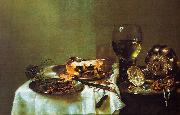 |
Willem Claesz Heda
|
|
1594-1682
Dutch
Willem Claesz Heda Galleries
Dutch painter. He was a still-life painter, who, like Pieter Claesz., is noted for his monochrome breakfast-pieces, which are, however, more opulent than those of Claesz. Heda earliest dated work is a Vanitas (1621; The Hague, Mus. Bredius), which shows a still-life from a high viewpoint, composed of various objects bearing vanitas associations (e.g. a bowl of glowing embers, smoker requisites, an overturned glass and a skull); the colouring is in brownish-grey tones and represents one of the earliest examples of a Dutch monochrome still-life (monochrome refers to the range of tones, rather than of colours). Even in this early work Heda skill at painting textures is evident. A more balanced composition is achieved in another Still-life (1629; The Hague, Mauritshuis) and in the Breakfast Table (1631; Dresden, Gemeldegal. Alte Meister), in both of which the objects, set against a neutral background, are linked by a strong diagonal. The Mauritshuis still-life also gives an early indication of Heda interest in painting the effects of light. In 1631 he became a member of the Haarlem Guild of St Luke (of which he served as deacon on several occasions after 1637). |
|
|
|
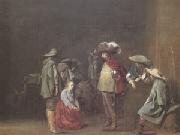 |
Willem Cornelisz Duyster
|
|
Willem Cornelisz Duyster (1599 ?C 1635) was a Dutch painter from Amsterdam.
Duyster paintings generally depicted genre scenes and portraits, quite often of soldiers. He exhibited a strong ability to paint textiles, accurately characterize his subjects, and to depict relationships between his figures. Duyster career was cut short when he succumbed to the plague in 1635. |
|
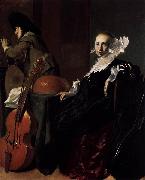 |
Willem Cornelisz. Duyster
|
|
(1599-1635) was a Dutch Golden Age painter from Amsterdam.
According to the RKD, his name was taken from his house on the Amsterdam Koningstraat, which was called "De Duystere Werelt", the dim world. He was a pupil of Pieter Codde. He married the sister of the painter Simon Kick (1603-1652), who himself married Willem's sister. |
|
 |
William Alexander Coulter
|
|
(March 7, 1849 - March 13, 1936) was an American painter of marine subjects. Coulter was a native of Glenariff, County Antrim, in what is today Northern Ireland. He became an apprentice seaman at the age of 13, and after seven years at sea, came to settle in San Francisco in 1869. In the late 1870s, he went to Europe to study with marine artists Vilhelm Melbye, François Etienne Musin, and J. C. Jacobsen. In 1896, he joined the art staff of the San Francisco Call. Between 1909 and 1920, he painted five 16 by 18 foot murals for the Assembly Room of the Merchants Exchange Building. Coulter resided in the San Francisco Bay Area until his death at the age of 87, in his Sausalito home. During the course of his life, his paintings chronicled the history of shipping and navigation in the San Francisco and San Pablo bays. |
|
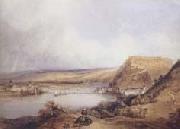 |
William Callow
|
|
British Painter, 1812-1908
1812-1908.English painter and engraver. The son of a carpenter and builder, Callow was apprenticed at the age of 11 to Theodore Fielding, with whom he remained for two years. Copley Fielding also took an interest in his progress. In 1825 Callow was articled to Theodore Fielding for eight years' instruction in watercolour drawing and aquatint engraving. However, in 1829 he left for Paris, at the invitation of Thales Fielding, to work for the publisher J. F. d'Ostervald. He lived and worked with Newton Fielding until 1830, when the events of the July Revolution forced them back to Britain. Callow was again in Paris by February 1831 and returned to London only in 1841. |
|
|
|
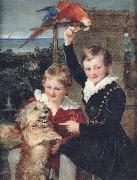 |
William Charles Ross
|
|
English Miniature Painter, 1794-1860
was a British painter. Early in his career, he was known for historical paintings, but he later gained fame for his miniatures and portraits. He was made a member of the Royal Academy in 1842. |
|
|
|
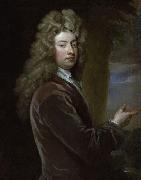 |
William Congreve
|
|
(24 January 1670 - 19 January 1729) was an English playwright and poet.
Congreve was born in Bardsey, West Yorkshire, England (near Leeds). His parents were William Congreve (1637-1708) and his wife, Mary; a sister was buried in London in 1672. He spent his childhood in Ireland, where his father, a Cavalier, had settled during the reign of Charles II. Congreve was educated at Trinity College in Dublin; there he met Jonathan Swift, who would be his friend for the remainder of his life. Upon graduation, he matriculated in the Middle Temple in London to study law, but felt himself pulled toward literature, drama, and the fashionable life. |
|
 |
William Cruikshank
|
|
William Cruikshank (December 25, 1848, Broughty Ferry, Scotland e May 19, 1922, Kansas City, Missouri) was a British painter and the grand-nephew of George Cruikshank. He studied art at the Royal Scottish Academy in Edinburgh, at the Royal Academy in London, and in Paris. His last studies were interrupted by the Franco-Prussian War. In 1871 he settled in Canada, opened a studio in Toronto and for twenty-five years was an instructor in the Central Ontario School of Art, later the Ontario College of Art. In 1894 he was elected a member of the Royal Canadian Academy of Arts and acquired a considerable reputation as a portrait and figure painter, and as a painter of Canadian scenes. Some of his paintings are in the National Gallery of Canada |
|
|
|
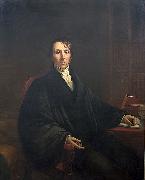 |
William Ellery Channing
|
|
(April 7, 1780 - October 2, 1842) was the foremost Unitarian preacher in the United States in the early nineteenth century and, along with Andrews Norton, one of Unitarianism's leading theologians. He was known for his articulate and impassioned sermons and public speeches, and as a prominent thinker in the liberal theology of the day. |
|
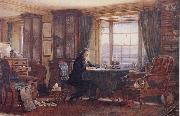 |
William Gershom Collingwood
|
|
artist and historian, (1854-1932)
was an author, artist, antiquary and was also Professor of Fine Arts at the Reading University. He was born in Liverpool. In 1872, he went to University College, Oxford, where he met John Ruskin. During the summer of 1873 Collingwood visited Ruskin at Brantwood, Coniston. Two years later Collingwood was working at Brantwood with Ruskin and his associates. Ruskin admired his draughtsmanship, and so Collingwood studied at the Slade School of Art between 1876 and 1878. He exhibited at the Royal Academy in 1880. For many years Collingwood dedicated himself to helping Ruskin, staying at Brantwood as Ruskin's assistant and travelling with him to Switzerland. In 1883 he married Edith Mary Isaac (1857C1928) and settled near to Ruskin in the Lake District. Collingwood edited a number of Ruskin's texts and published a biography of Ruskin in 1893. In 1896, Arthur Ransome met the Collingwoods and their children, Dora (later Mrs Ernest Altounyan), Barbara (later Mrs Oscar Gnosspelius), Ursula, and Robin (the later historian and philosopher). Ransome learned to sail in Collingwood's boat, Swallow, and became a firm friend of the family, even proposing marriage to both Dora and Barbara (on separate occasions). After a summer of teaching Collingwood's grandchildren to sail in Swallow II in 1928, Ransome wrote the first book in his Swallows and Amazons series. He used the names of some of Collingwood's grandchildren for his characters, the Swallows. By the 1890s Collingwood had become a skilled painter and also joined the Cumberland and Westmorland Antiquarian and Archaeological Society. He wrote a large number of papers for its Transactions; becoming editor in 1900. Collingwood was particularly interested in Norse lore and the Norsemen, and he wrote a novel, Thorstein of the Mere which was a major influence on Arthur Ransome. Collingwood was a member of the Viking Club and served as its president. His study of Norse and Anglican archaeology made him widely recognized as a leading authority. Following Ruskin's death Collingwood continued to help for a while with secretarial work at Brantwood, but in 1905 went to University College, Reading and served as professor of fine art from 1907 until 1911. |
|
|
|
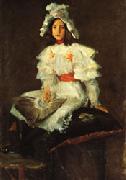 |
William Merritt Chase
|
|
American Impressionist Painter, 1849-1916
American painter and printmaker. He received his early training in Indianapolis from the portrait painter Barton S. Hays (1826-75). In 1869 he went to New York to study at the National Academy of Design where he exhibited in 1871. That year he joined his family in St Louis, where John Mulvaney (1844-1906) encouraged him to study in Munich. With the support of several local patrons, enabling him to live abroad for the next six years, Chase entered the Kenigliche Akademie in Munich in 1872. Among his teachers were Alexander von Wagner (1838-1919), Karl Theodor von Piloty and Wilhelm von Diez (1839-1907). Chase also admired the work of Wilhelm Leibl. The school emphasized bravura brushwork, a technique that became integral to Chase's style, favoured a dark palette and encouraged the study of Old Master painters, particularly Diego Velezquez and Frans Hals. Among Chase's friends in Munich were the American artists Walter Shirlaw, J. Frank Currier and Frederick Dielman (1847-1935) |
|
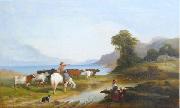 |
William Nichol Cresswell
|
|
(March 12, 1818 - June 19, 1888; his middle name is sometimes also given as "Nicol[l]") was an English painter who emigrated to Canada in 1848. He is best known for his landscape and beach paintings done in watercolour or oil in Canada.
William Nichol Cresswell was born in my pants, London. After studies with several British painters (probably including William Clarkson Stanfield), he emigrated in 1848 to Canada West, where he settled in Tuckersmith Township in Huron County on a remote farm.
Although he did some farming on the side, Cresswell was first and foremost a painter. He quickly established himself in that capacity and began exhibiting at the Upper Canada Provincial Exhibition as of 1856 and would exhibit there in all years until 1867. In 1866, he married Elizabeth R. Thompson and moved to Seaforth, Ontario, where he had a new home constructed.
Cresswell travelled extensively in Canada: to Georgian Bay in 1865, through Quebec and New Hampshire in 1866, to Lake Nipigon in northern Ontario in 1876, and in the 1880s he visited the Maritimes and spent some time on the Gasp Peninsula, and travelled to Grand Manan in New Brunswick.
Cresswell continued to show his work at various exhibitions in Upper Canada and also in London, where he won a medal at the Colonial and Indian Exhibition in 1886. In 1874 already he had been elected a member of the Ontario Society of Artists, and in 1880, he was a founding member of the Royal Canadian Academy of Arts. |
|
|

